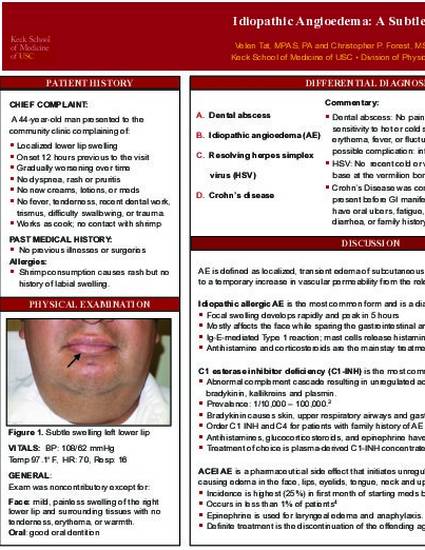
Presentation
Poster: Idiopathic Angioedema: A Subtle Presentation
American Academy of Physician Assistants / 40th Annual Conference
(2016)
Abstract
Idiopathic Allergic Angioedema (AE) is the most common form and is a diagnosis of exclusion
§Focal swelling develops rapidly and peak in 5 hours
§Mostly affects the face while sparing the gastrointestinal and laryngeal mucosa4
§Ig-E-mediated Type 1 reaction; mast cells release histamine or vasoactive mediators
§Antihistamine and corticosteroids are the mainstay treatment of idiopathic AE
C1 esterase inhibitor deficiency (C1-INH) is the most common form of hereditary AE
§Abnormal complement cascade resulting in unregulated activity of vasoactive mediators bradykinin, kallikreins and plasmin.
§Prevalence: 1/10,000 – 100,000.3
§Bradykinin causes skin, upper respiratory airways and gastrointestinal tract symtpoms
§Order C1 INH and C4 for patients with family history of AE or suspect C1-INH deficiency
§Antihistamines, glucocorticosteroids, and epinephrine have little to no effect hereditary AE
§Treatment of choice is plasma-derived C1-INH concentrate
ACEI AE is a well-documented pharmaceutical side effect that initiates unregulated bradykinin production causing edema in the face, lips, eyelids, tongue, neck and upper airways with airway obstruction dangers. The incidence is highest (25%) within the first month of starting medication but may present years after use.2ACEI AE occurs in less than 1% patients taking ACEI therapy.4 Epinephrine is used for laryngeal edema and anaphylaxis. Definite treatment is the discontinuation of the offending agent.
Successful AE management requires detection and avoidance of triggers, early recognition of acute attacks, and aggressive airway management. The most common type of AE is idiopathic and responds to antihistamine and corticosteroids. If the patient is not responding to treatment, consider hereditary or medication induced AE.
Keywords
- Angioedema,
- Dermatology,
- ACE Inhibitor
Disciplines
Publication Date
May, 2016
Location
San Antonio, TX
Citation Information
Velen Tat and Christopher Forest. "Poster: Idiopathic Angioedema: A Subtle Presentation" American Academy of Physician Assistants / 40th Annual Conference (2016) Available at: http://works.bepress.com/christopher-forest/59/
